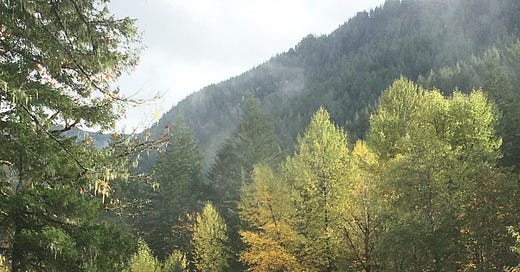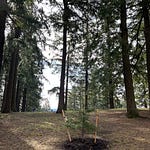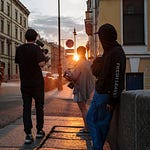Photo by the author
Hello everyone,
I’m leaving town today to spend a couple of days at the base of Mt. Hood. I’m going to stay at a cabin on a river that I visit often—the picture at the top of the page is a photograph I took one day in the fall while I was hiking there.
Before I leave, I wanted to share with you a short quote from Thich Nhat Hanh’s The Miracle of Mindfulness. The book is an introduction to meditation. But it’s sneaky. One of the “beginning meditations” is the meditation on interdependence that I think it could take me a lifetime to understand.
He cautions the reader not to sit and think about the philosophy of interdependence. Rather, the goal of the meditation is to actually feel that there is no subject and no object, there is no difference, no separation, between the “self” and the “world,” or between consciousness and what it perceives, or between myself and a person who is suffering, or who I believe is “causing me harm.”
One way to perceive interdependence, before you start softening the boundaries of the self, is to focus on the ways any object that appears separate from its environment could not exist without everything around it. For example, there is this thing, a table. It’s in your dwelling. But to perceive that table in that way is to break its relationship with everything that allowed it to be.
He talks about the tree and the not tree, here:
The table’s existence is possible due to the existence of things which we might call “the non-table world”: the forest where the wood grew and was cut, the carpenter, the iron ore which became the nails and screws, and countless other things which have relation to the table, the parents and ancestors of the carpenter, the sun and rain, which made it possible for the trees to grow.
If you grasp the table’s reality then you see that in the table itself are present all those things which we normally think of as the non-table world. If you took away any of those non-table elements and returned them to their sources—the nails back to the iron ore, the wood to the forest, the carpenter to his parents—the table would no longer exist.
A person who looks at the table and can see the universe is a person who can see the way.
For me, it’s easy to engage the philosophy of interdependence, and mind-blowingly difficult to sit and actually perceive interdependence in real time. To perceive interdependence is to obliterate the idea of the self and the false sense that it is a being or thing that is separate from experience, and thus can evaluate it, judge it, enjoy it, feel distant from it, etc.
Because I was reading his book, and not meditating, and because thinking is easier than meditating, I came up with a thought that I wanted to share with you all. I was thinking about the fact that one of the reasons I write about ideology and structures and systems so much in this newsletter is because I want to make visible the artificial and constructed nature of ideas, ideas that are made real in the world through systems that cause pain and harm and suffering. To make these systems visible as constructions is to make them available to change.
What’s tricky about ideologies is that they work like water wheels:
Image from Pixabay on Pexels
The ideas of a particular ideology, such as white supremacy, circulate throughout the dominant culture, turning and turning like the water falling from one bucket to the next on the wheel.
We also have experiences as individuals, or groups, or as a culture, that interrupt the wheel and stop its turning. The interruptions happen when white supremacy is made visible as it enacts violence. The horror of its violence introduces new ideas, new movements, that challenge and make visible the constructed nature of ideology. But then, like the wagon wheel, white supremacy reasserts itself as natural, as inevitable, as timeless, as irrefutable—not just as a collection of ideas, and separate acts, but as a system, a network, representing itself as culturally entrenched.
White supremacy is not only the series of actions and beliefs that result in physical effects, such as the allocation of resources, power, safety, and money to people who are coded as white. White supremacy is also an ideology that represents itself as timeless, as not actually available to be challenged and overthrown.
The hopelessness you may have felt, at some point, about actually transforming white supremacy is in part about that wagon wheel recirculating, teaching you not only its content, but also its form: that it won’t budge, that it will just keep turning, keep harming, keep its devastation going.
The force and the violence of white supremacy in the real world is overwhelming and catastrophic. But it is equally catastrophic to inculcate in a culture the idea that it cannot be contested, that it will not ever leave. Because if the belief that it is timeless and unchanging takes hold, even unconsciously, the person who has that belief is less likely to engage in action for change, or to think of new ways to create a culture that does not depend on white supremacy.
It occurred to me that the meditation on interdependence could be seen as one of the most subversive ways to feel and know the constructed nature of ideologies, and the systems of violence that are its effects.
To perceive interdependence—rather than think about interdependence—is to achieve, even for a moment, the fact of oneness. It is to evade the mirage of separation upon which so much of the violence of ideologies depend. Because ideologies of domination depend on separation as the ground, the floor upon which they stand: they can only function when there is a subject and an object who is derided, evaluated, judged, found wanting. The subject is granted full personhood; the object is robbed of being.
To perceive oneness—to know oneness in the experience of being is to have one breath, one moment, that systems of violence cannot enter. It is a power that is available at all times. It is a mode of concentration, but it also a practice of self reinforcement—that is, not that we reinforce the idea of a self, which is a fiction, a construct, but rather we reinforce our value as part of the value of all beings, and are thus fortified in continuing to turn toward violence, to stay with it, to better understand how it works.
I’m going to try that meditation at the river, and I’ll let you know how it goes. If you want to take this post as an Action Snack and try it, too, I’d love to hear what happened for you.
Thanks as always for reading and listening—
xo
Rebecca














Share this post